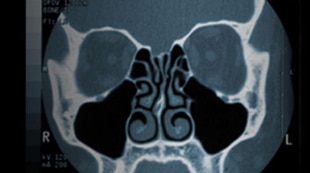WHEN SINUS INFECTIONS BECOME SINUSITIS
You know the feeling: runny nose, headache, sinus congestion. Is it just a cold? Or something more serious? If it’s a sinus infection, that’s a much more serious condition. About 31 million Americans suffer from chronic sinus infections — known as sinusitis.1 If you’re one of them and continue to battle sinus pain, headaches, and emotional drain for 12 weeks or more no matter what treatments you try, you may be dealing with chronic rhinosinusitis (CRS).1,2
WHAT’S HAPPENING IN YOUR SINUSES?
Your sinuses are bony, air-filled cavities inside your face and skull. A sinus infection, also called rhinosinusitis, is an inflammation of the soft tissues that line the sinuses. This inflammation or swelling can stop your sinuses from draining properly. The buildup can then lead to infection, which causes even more inflammation and pain.
You have four types of sinuses — frontal, ethmoid, sphenoid, and maxillary — and sinusitis can affect any of them.

- Frontal sinuses
- Ethmoid sinuses
- Sphenoid sinuses
- Maxillary sinuses
SINUSITIS SYMPTOMS
Sinus congestion, discharge, and pressure with facial pain or headaches could mean you have a cold. But if the discharge from your nose is yellow or discolored, you may have a sinus infection.
Chronic sinus infections can reduce your quality of life and make you constantly tired. If you have asthma, sinus infections may make it worse.
PHYSICAL SYMPTOMS
- Headaches
- Facial pain or pressure
- Difficulty breathing through the nose
- Nasal discharge that isn't clear
- Fever
- Fatigue
- Upper tooth pain
- Bad breath
EMOTIONAL SYMPTOMS
- Limiting physical activities
- Taking sick days from work
- Being too ill to socialize
- Nasal discharge that isn't clear
- Having problems sleeping
- Feeling moody and miserable
- Avoiding social situations
TYPES OF SINUSITIS
There are two kinds of sinusitis. A short-term or acute sinus infection can occur after a cold, an allergy attack, or from pollutants in the environment. A long-term or chronic sinus infection is one that lasts longer than 12 weeks.
| Up to 4 weeks | Acute |
| Longer than 4 weeks, less than 12 weeks | Subacute |
| 12 weeks or longer | Chronic |
| Occurs 4+ times per year, but goes away between episodes | Recurrent acute sinusitis |
DO YOU HAVE CHRONIC SINUSITIS?
Fill out a short self-assessment to find out whether you may be suffering from chronic sinusitis.
CAUSES OF SINUSITIS
Doctors classify the causes of sinusitis this way:
- Anatomical causes — such as a deviated septum or enlarged turbinates in your nose
- Inflammatory and infectious causes — related to bacterial, viral, and fungal infections, as well as allergies and polyps
- Developmental disorders — like cystic fibrosis
- Tumors in the nose and sinuses — these can block critical drainage pathways
The underlying cause behind your sinusitis may have implications for how you respond to treatment and which treatment options your doctor recommends.
RISK FACTORS
These factors can increase your risk of a sinus infection:
- Swimming in polluted water exposes your sinuses to bacteria.
- Frequent contact with young children exposes you to a greater number of colds or bacterial infections.
- Smoking or secondhand smoke thickens the tissue in your nose, slows down the flow of mucus, and allows bacteria to grow.
DIAGNOSING SINUSITIS

To diagnose a sinus infection, your doctor will ask about your symptoms and medical history. He or she may tap areas of your face to find out if any sinus openings are tender. Your doctor may also take a sample of your nasal discharge to determine what kind of infection you might have.
Your doctor may order a CT scan that creates images of the inside of your sinuses. This can help your doctor more accurate diagnose your condition and select the best treatment option for you.3
EXPLORE TREATMENT OPTIONSRosenfeld RM, Andes D, Bhattacharyva N, et al. Clinical practice guidelines: Adult sinusitis. Otolaryngol Head Neck Surg.2007;137:S1-S31.
Data on File. Medtronic, Inc.
American Rhinologic Society. Sinusitis Q&A. http://care.american-rhinologic.org/sinusitis_q_a? Accessed October 16, 2015.
Information on this site should not be used as a substitute for talking with your doctor. Always talk with your doctor about diagnosis and treatment information.